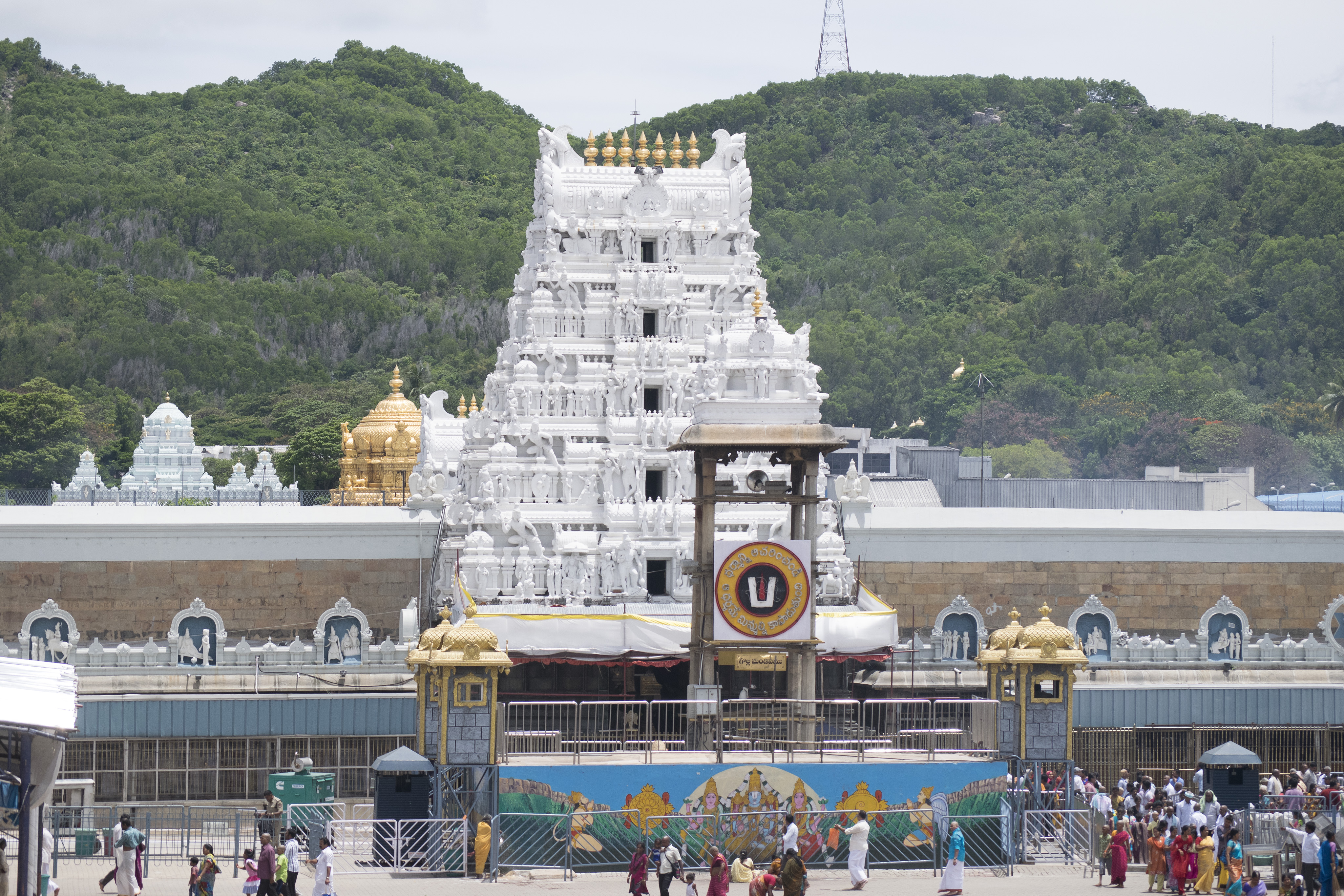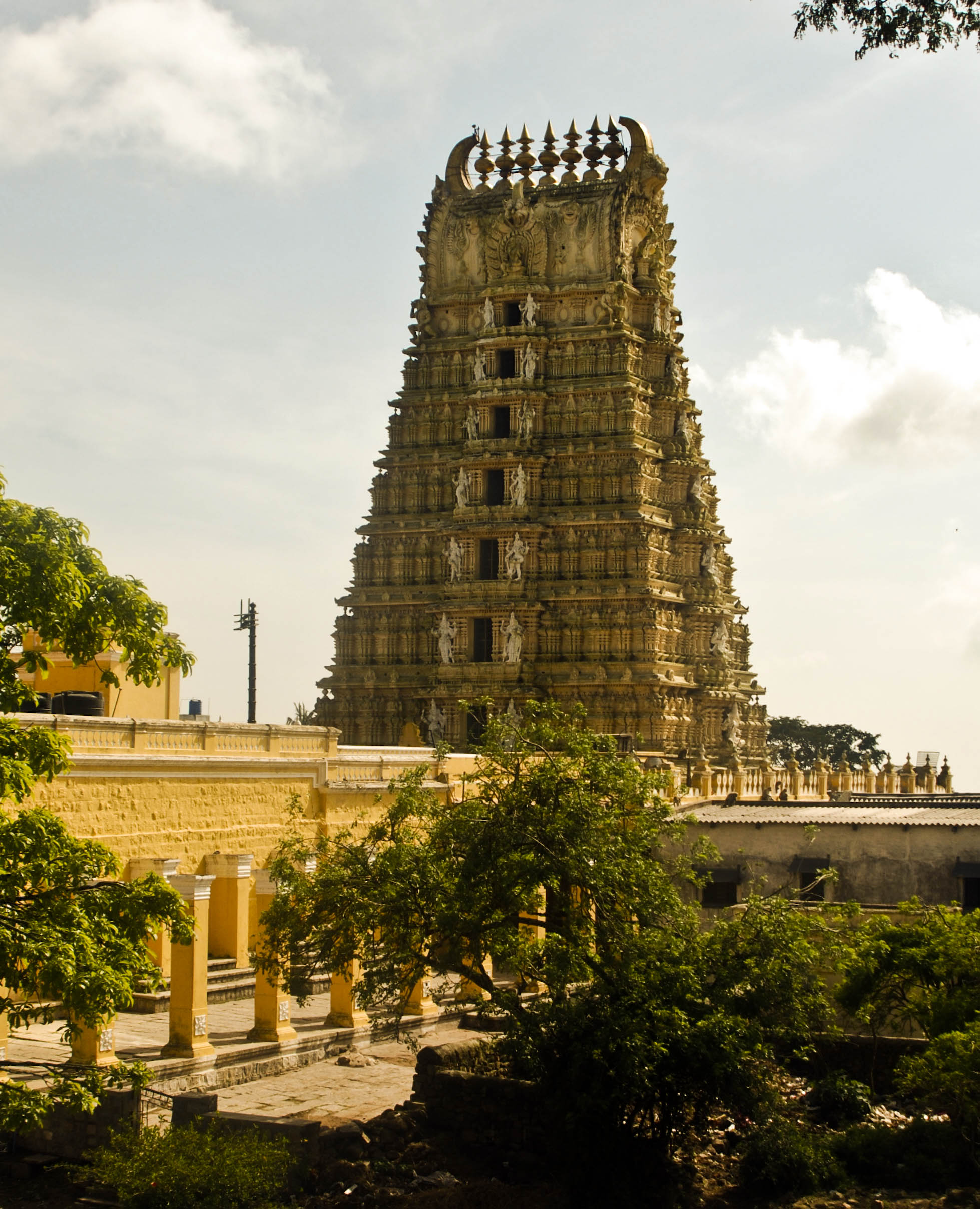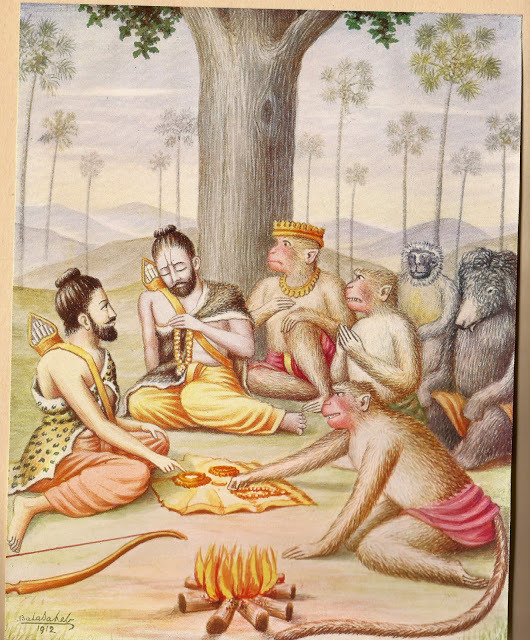|
Nava Brindavana
Nava Brindavana (also known as Navavrundhaavana); (Kannada:ನವ ಬೃಂದಾವನ), is located on an island in the Tungabhadra River at Anegundi, near Hampi, Karnataka, India. The Brindavanas of nine Hindu Madhva saints present in Nava Brindavana belongs to the Uttaradi Math, Vyasaraja Math and Raghavendra Math . All these saints are descended from Padmanabha Tirtha, direct disciple of Jagadguru Madhvacharya. List of Saints in Nava Brindavana The nine saints in Nava Brindavana are as follows: # Padmanabha Tirtha, # Kavindra Tirtha # Vagishatirtha # Vyasatirtha # Srinivasa Tirtha # Ramatirtha # Raghuvarya Tirtha, # Sudhindra Tirtha, # Govinda Wodeyar There are also shrines to Lord Ranganatha and Lord Hanuman inside the premises. History Nava Brindavana is located in Angundi which was earlier part of Kishkindha, a mythological kingdom ruled by Sugriva. In Ramayana, when Raama and Lakshmana were in search of Seeta, Raama pointed out an island (called 'Navabrundhaa ... [...More Info...] [...Related Items...] OR: [Wikipedia] [Google] [Baidu] |
Raghuttama Tirtha
Raghuttama Tirtha (Sanskrit:रघूत्तम तीर्थ); IAST:Śrī Raghūttama Tīrtha) ( 1548 - 1596), was an Indian philosopher, scholar, theologian and saint. He was also known as Bhavabodhacharya (). His diverse oeuvre include commentaries on the works of Madhva and Jayatirtha. He served as the fourteenth pontiff of Madhvacharya Peetha - Uttaradi Math from 1557 to 1595, which he occupied, with remarkable distinction for thirty-nine years. He is considered to be one of the most important seers in the history of Dvaita school of thought. His shrine at Tirukoilur attracts thousands of visitors every year. Born in an aristocratic Brahmin family, but was brought up in mutt under the direction of Raghuvarya Tirtha. He composed 11 works, consisting of commentaries on the works of Madhva, Jayatirtha and Vyasatirtha in the form of ''Bhāvabodhas'' elaborating upon the Dvaita thought. Life Most of the information about Raghuttama Tirtha's life is derived from ha ... [...More Info...] [...Related Items...] OR: [Wikipedia] [Google] [Baidu] |
Vijayanagara Empire
The Vijayanagara Empire, also called the Karnata Kingdom, was a Hindu empire based in the region of South India, which consisted the modern states of Karnataka, Andhra Pradesh, Tamil Nadu, Kerala, Goa and some parts of Telangana and Maharashtra. It was established in 1336 by the brothers Harihara I and Bukka Raya I of the Sangama dynasty, members of a pastoralist cowherd community that claimed Yadava lineage. The empire rose to prominence as a culmination of attempts by the southern powers to ward off Perso-Turkic Islamic invasions by the end of the 13th century. At its peak, it subjugated almost all of South India's ruling families and pushed the sultans of the Deccan beyond the Tungabhadra-Krishna river doab region, in addition to annexing modern day Odisha (ancient Kalinga) from the Gajapati Kingdom thus becoming a notable power. It lasted until 1646, although its power declined after a major military defeat in the Battle of Talikota in 1565 by the combined arm ... [...More Info...] [...Related Items...] OR: [Wikipedia] [Google] [Baidu] |
Vyasaraja Navabrindhavan
Vyāsatīrtha (. 1460 – 1539), also called ''Vyasaraja'' or ''Chandrikacharya'', was a Hindu philosopher, scholar, polemicist, commentator and poet belonging to the Madhwacharya's Dvaita order of Vedanta. As the patron saint of the Vijayanagara Empire, Vyasatirtha was at the forefront of a golden age in Dvaita which saw new developments in dialectical thought, growth of the Haridasa literature under bards like Purandara Dasa and Kanaka Dasa and an amplified spread of Dvaita across the subcontinent. Three of his polemically themed doxographical works ''Nyayamruta'', ''Tatparya Chandrika'' and ''Tarka Tandava'' (collectively called ''Vyasa Traya'') documented and critiqued an encyclopaedic range of sub-philosophies in Advaita, Visistadvaita, Mahayana Buddhism, Mimamsa and Nyaya, revealing internal contradictions and fallacies. His ''Nyayamruta'' caused a significant stir in the Advaita community across the country requiring a rebuttal by Madhusudhana Saraswati through h ... [...More Info...] [...Related Items...] OR: [Wikipedia] [Google] [Baidu] |
Mysore
Mysore (), officially Mysuru (), is a city in the southern part of the state of Karnataka, India. Mysore city is geographically located between 12° 18′ 26″ north latitude and 76° 38′ 59″ east longitude. It is located at an altitude of above mean sea level. Mysore is situated at the foothills of Chamundi Hills about towards the southwest of Bangalore and spread across an area of . Mysore City Corporation is responsible for the civic administration of the city, which is also the headquarters of Mysore district and Mysore division. It served as the capital city of the Kingdom of Mysore for nearly six centuries from 1399 until 1956. The Kingdom was ruled by the Wadiyar dynasty, with a brief period of interregnum in the late 18th century when Hyder Ali and Tipu Sultan were in power. The Wadiyars were patrons of art and culture. Tipu Sultan and Hyder Ali also contributed significantly to the cultural and economic growth of the city and the state by planting ... [...More Info...] [...Related Items...] OR: [Wikipedia] [Google] [Baidu] |
Vidyadhiraja Tirtha
Vidyadhiraja Tirtha was a Hindu philosopher, dialectician and the seventh pontiff of Madhvacharya Peetha and served as peetadhipathi from (c. 1388 – c. 1392). Bifurcation of Mathas It was during the time of Vidyadhiraja Tirtha that the first bifurcation of the Madhva Mathas took place. According to tradition Vidyadhiraja want to ordain Rajendra Tirtha, one of his disciples, to succeed him on the pontifical throne. But when Vidyadhiraja fell ill and the time came for formally handing over Matha to Rajendra Tirtha, the latter, who was on tour at the critical juncture. So Vidyadhiraja ordained his disciple Kavindra to succeed him on the pontifical throne. This selection of Kavindra Tirtha as the successor of Vidyadhiraja, leaving Rajendra Tirtha resulted in the bifurcation of the Madhva Mathas, namely Uttaradi Matha presided by Kavindra Tirtha and Vyasaraya Matha at Sosale headed by Rajendra Tirtha. Kavindra Tirtha was formally crowned as "Vedanta Samrat" by his Guru Vidyadhi ... [...More Info...] [...Related Items...] OR: [Wikipedia] [Google] [Baidu] |
Vishnu
Vishnu ( ; , ), also known as Narayana and Hari, is one of the principal deities of Hinduism. He is the supreme being within Vaishnavism, one of the major traditions within contemporary Hinduism. Vishnu is known as "The Preserver" within the Trimurti, the triple deity of supreme divinity that includes Brahma and Shiva. Gavin Flood, An Introduction to Hinduism' (1996), p. 17. In Vaishnavism, Vishnu is the supreme being who creates, protects, and transforms the universe. In the Shaktism tradition, the Goddess, or Adi Shakti, is described as the supreme Para Brahman, yet Vishnu is revered along with Shiva and Brahma. Tridevi is stated to be the energy and creative power ( Shakti) of each, with Lakshmi being the equal complementary partner of Vishnu. He is one of the five equivalent deities in Panchayatana puja of the Smarta tradition of Hinduism. According to Vaishnavism, the highest form of Ishvara is with qualities ( Saguna), and have certain form, but is limit ... [...More Info...] [...Related Items...] OR: [Wikipedia] [Google] [Baidu] |
Ramayana
The ''Rāmāyana'' (; sa, रामायणम्, ) is a Sanskrit epic composed over a period of nearly a millennium, with scholars' estimates for the earliest stage of the text ranging from the 8th to 4th centuries BCE, and later stages extending up to the 3rd century CE. ''Ramayana'' is one of the two important epics of Hinduism, the other being the ''Mahābhārata''. The epic, traditionally ascribed to the Maharishi Valmiki, narrates the life of Sita, the Princess of Janakpur, and Rama, a legendary prince of Ayodhya city in the kingdom of Kosala. The epic follows his fourteen-year exile to the forest urged by his father King Dasharatha, on the request of Rama's stepmother Kaikeyi; his travels across forests in the Indian subcontinent with his wife Sita and brother Lakshmana, the kidnapping of Sita by Ravana – the king of Lanka, that resulted in war; and Rama's eventual return to Ayodhya to be crowned king amidst jubilation and celebration. The ''Ramayana'' is ... [...More Info...] [...Related Items...] OR: [Wikipedia] [Google] [Baidu] |
Sugriva
''This character is about the vanara, in the Ramayana.'' Sugriva ( sa, सुग्रीव, , ) is a character In the ancient Indian epic Ramayana. He is the younger brother of Vali (Ramayana), Vali, whom he succeeded as ruler of the vanara kingdom of Kishkindha. Rumā is his wife. He is a son of Surya, the Hindu deity of the sun. As the king of the vanaras, Sugriva aided Rama in his quest to liberate his wife Sita from captivity at the hands of the rakshasa king Ravana. Nomenclature He is also known as jv, Sugriwa, th, Su-khrip, lo, Sugeep, km, Sukhreeb, Creole language, Creole: ''Soogrim'', lo, Sangkip, ta, Cukkirivan, my, Thugyeik, Sugreeva or Sugreev. Legend The story of Sugriva is part of Ramayana and in an abbreviated version, is also present in the Mahabharata. The king of Kishkindha, Vrikshraja, was a divine creature born from Brahma’s tilaka. He had the body of a human and face and tail of a monkey. He was instructed to roam the forests and kill demons ... [...More Info...] [...Related Items...] OR: [Wikipedia] [Google] [Baidu] |
Kishkindha
Kishkindha (, ) is a kingdom of the vanaras in Hinduism Hinduism () is an Indian religion or ''dharma'', a religious and universal order or way of life by which followers abide. As a religion, it is the world's third-largest, with over 1.2–1.35 billion followers, or 15–16% of the global po .... It is ruled by King Sugriva, the younger brother of Bali (Ramayana), Vali, in the Sanskrit epic ''Ramayana''. According to the Hinduism, Hindu epic, this was the kingdom that Sugriva ruled with the assistance of his counsellor, Hanuman. During the Treta Yuga, the whole region was within the dense Dandaka Forest which was founded by King Danda, son of Ikshvaku, and descendant of Vaivasvata Manu in the Satya Yuga, which extended from the Vindhya range to the South Indian peninsula. Thus, this kingdom was considered that of the vanaras. During the Dvapara Yuga, the Pandava Sahadeva is stated to have visited this kingdom in the epic ''Mahabharata'' during his southern military ... [...More Info...] [...Related Items...] OR: [Wikipedia] [Google] [Baidu] |
Hanuman
Hanuman (; sa, हनुमान, ), also called Anjaneya (), is a Hindu god and a divine '' vanara'' companion of the god Rama. Hanuman is one of the central characters of the Hindu epic ''Ramayana''. He is an ardent devotee of Rama and one of the Chiranjivis. Hanuman is regarded to be the son of the wind-god Vayu, who in several stories played a direct role in Hanuman's birth, and considered to be an incarnation or son of Shiva in Shaivism. Hanuman is mentioned in several other texts, such as the epic ''Mahabharata'' and the various Puranas. Evidence of devotional worship to Hanuman is largely absent in these texts, as well as in most archeological sites. According to Philip Lutgendorf, an American Indologist, the theological significance of Hanuman and devotional dedication to him emerged about 1,000 years after the composition of the ''Ramayana'', in the 2nd millennium CE, after the arrival of Islamic rule in the Indian subcontinent.Paula Richman (2010), ''Revie ... [...More Info...] [...Related Items...] OR: [Wikipedia] [Google] [Baidu] |

.jpg)





